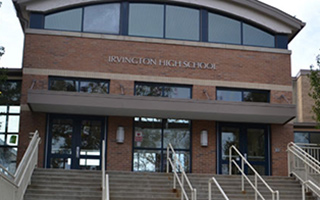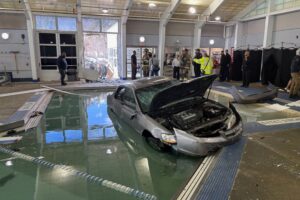 Eight teachers at Irvington High School are becoming regular visitors in their students’ homes (at least virtually) as part of a new instructional strategy the district is experimenting with known as “flipping classrooms.” The concept, gaining popularity across the country, involves turning the traditional teaching method on its head.
Eight teachers at Irvington High School are becoming regular visitors in their students’ homes (at least virtually) as part of a new instructional strategy the district is experimenting with known as “flipping classrooms.” The concept, gaining popularity across the country, involves turning the traditional teaching method on its head.
Rather than students sitting for a lecture and then working on the material at home via homework, they watch an online video or Powerpoint presentation at home that has been created by or voiced-over by their teacher, then come into the class to do their work.
“The idea of the flipped classroom is to make the classroom a more active environment so that all kids are engaged,” says Dr. Raina Kor, Irvington Assistant Superintendent for Curriculum and Human Resources. “What we’re saying is we want the most valuable resources in schools – our teachers – and we want to give kids as much time with teachers as we possibly can.”
Dr. Kor explains that despite the catchy name and unorthodox approach, flipping classrooms is nothing more than one more instructional tool a teacher can put in his or her arsenal when choosing how best to instruct the students. “There’s no one way to teach. There’s no one way to learn. Our goal as a district is to offer a variety of entry points for kids,” she says. “Clearly what makes flipping classrooms a little different is it feels very different from what we’re used to.”
Once committed to exploring a flipped classroom model, the administration identified eight teachers to be part of the initial pilot group to evaluate the strategy’s effectiveness. The administration provided them with whatever support they required if they chose to “flip” any of their lessons. “Most of the teachers have tried this for a couple of lessons,” says Dr. Kor. “It is not something you do every single day.”
The process takes some getting used to. Megan O’Donnell’s son is in the tenth grade, and is part of a flipped classroom. “I think my son had a little trouble adjusting in the beginning,” she admits. “He was watching the video at night and it wasn’t fresh in his mind when he entered the classroom the next day, but he’s gotten past that. He likes it now, but yes, it took some getting used to.”
Not everyone is a fan of the flipped classroom model, however. “It’s another education fad, and one of the worst ones out there,” says Irvington parent Catherine Johnson, who teaches at the college level.
Johnson argues that watching a presentation alone at home is not a good way to absorb information. That is not to say that she is against online presentations altogether. “I think it’s great when teachers post their Powerpoints online for students to use as review,” she says. She simply worries that relying on a Powerpoint as the initial source of a lesson doesn’t allow the student to investigate the material when it is fresh in their mind. “They’re not going to get their questions answered because they can’t ask their questions to the teacher,” she says.
Ironically, one of the biggest selling points of flipped classrooms is also one of its critics’ biggest concerns: the ability to rewind the presentation or online lecture to go back over something a student may not have initially understood. “If a child has difficulty mastering a concept, the video’s there,” says O’Donnell. “They can go over it three times, they can go over it four times until they get it.”
Johnson, however, believes rewatching material a student didn’t understand the first time misses the point. “When students have questions, simply hearing the same information in the same exact way – which is what happens on a rewind – doesn’t help,” she argues.
Though specific Irvington High School classes have been using the model for most of the year, their mention at a recent Board of Education meeting raised some eyebrows after it appeared that some members of the Board had never heard of the practice, suggesting that the administration had implemented the practice without notifying the Board as a group.
Not correct, says Board of Education President Robert Grados. “It was one of many proposals that they were going to consider rolling out in the district that we’re regularly kept apprised of,” he says. As for the indication that some Board members were unaware of the practice, Grados explains, “We’re five volunteers. We get information… in a lot of different ways. There’s a lot going on in a district of 1,800 students. For every Board member to be on top of every initiative happening — it’s fairly tough.”
In fact, some parents have known of the strategy for some time. “I was… aware of it prior to school starting,” says O’Donnell.
Some have asked the administration for evidence that the flipped classroom model is successful. However, the concept is relatively new – its genesis is credited to two teachers in Woodland Park, Colorado in 2007 – so not enough time has passed in order to come up with significant metrics. “I think [having] evidence is a little unrealistic considering it’s a fairly new instructional strategy being used in classrooms,” says Dr. Kor. “There’s probably not a lot of empirical evidence that it works or that it doesn’t work.”
Grados and the Board of Education hope the administration can provide that evidence over time. “We do need to find out whether it works for Irvington and if it works for our curriculum,” he says. “The Board expects and will ask – as we have asked with any effort that the administration [puts forth] – for them to give us the results of the findings of whether it has worked or not.”
Only time will tell if Irvington’s adventure into the instructional strategy of flipping classrooms will be a success, but from where Dr. Kor sits, things appear to be going well. “[Among] the parents of the kids who are in these classrooms…no one’s come forward to share a concern,” she says. “The teachers [in the initial cohort] all agreed on how much more time they’re getting to spend with kids one-on-one in small groups, and how much better they know their kids as learners. And that’s huge.”
For more information about flipped classrooms, check out this infographic at http://www.knewton.com/flipped-classroom/






